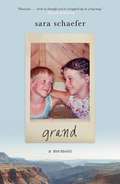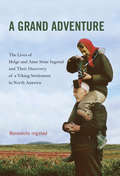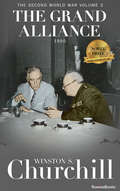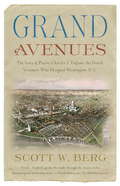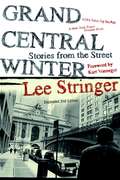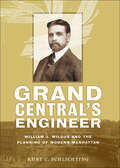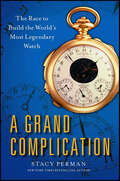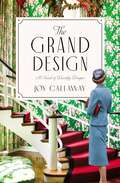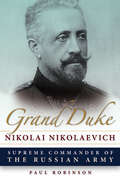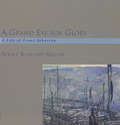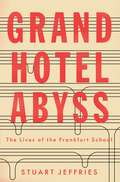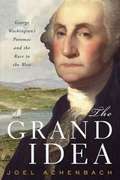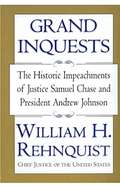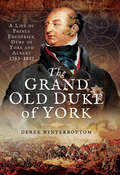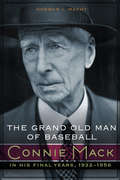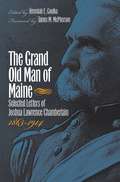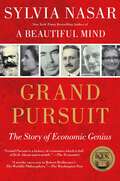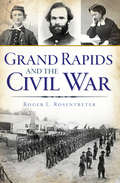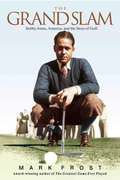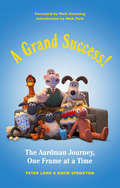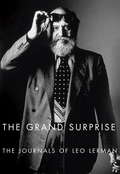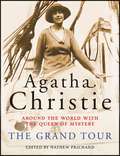- Table View
- List View
Grand: A Memoir
by Sara SchaeferFor fans of Mennonite in a Little Black Dress and Let&’s Pretend This Never Happened, comedian and Emmy award–winning writer Sara Schaefer&’s hilariously honest memoir follows Sara&’s trip through the Grand Canyon with her sister that causes her to reflect on her childhood and the scandal that changed her family forever.When Sara Schaefer is in first grade, her father warns her to always tell the truth because one lie leads to another and soon you will find yourself in a hole you can&’t escape. A few years later, the Schaefer family is completely upended when it&’s revealed that their grand life is based on a lie. Her parents become pariahs in their upper middle class community and go from non-religious people to devout church members. The idea of good and evil as binary, opposed forces is drilled into Sara and it becomes the perfect framework on which to build her anxiety and increasingly-obsessive thoughts. The year she turns forty, Sara decides to take each member of her family on a one-on-one vacation culminating with a whitewater rafting journey through the Grand Canyon with her younger sister. The only problem is she&’s terrified of rafting. Along the way, she grapples with unresolved grief over the death of her mother and the family scandal that changed the trajectory of her life. Heartfelt, candid, and witty, Grand is a story about family, identity, and struggling to make something of yourself. Sara deconstructs her struggles with anxiety and depression, what it means to be a good person, and the radically discordant stories we tell ourselves and share with the world.
Grand Adventure: The Lives of Helge and Anne Stine Ingstad and Their Discovery of a Viking Settlement in North America
by Benedicte IngstadIn 1960, Helge Ingstad and Anne Stine Ingstad made a discovery that rewrote the history of European exploration and colonization of North America – a thousand-year-old Viking settlement at L’Anse aux Meadows, Newfoundland. In A Grand Adventure, the Ingstads’ daughter Benedicte tells the story of their remarkable lives spent working together, sharing poignant details from her parent’s private letters, personal diaries, their dinner table conversations, and Benedicte’s own participation in her parents’ excavations. Following young Helge Ingstad from his 1926 decision to abandon a successful law practice for North American expeditions through Canada’s Barren Lands, Alaska’s Anaktuvuk Pass, and the mountains of northern Mexico, the story recounts his governorship of Norwegian territories and marriage to Anne Stine Moe. The author then traces Helge and Anne Stine’s travels around the world, focusing in particular on their discovery of the Viking settlement at the northern tip of Newfoundland. With Anne Stine as the head archaeologist, they excavate these ruins for eight years, while weathering destructive skepticism from academic peers, until indisputable evidence is unearthed and their find is confirmed. A remarkable look at a personal and professional relationship, A Grand Adventure shows two explorers’ unrelenting drive and unfailing courage.
The Grand Alliance: The Second World War, Volume 3 (Winston S. Churchill The Second World Wa #3)
by Winston S. ChurchillThe British, Soviets, and Americans unite in this chapter of the six-volume WWII history by the legendary prime minister and Nobel Prize recipient. The Grand Alliance describes the end of an extraordinary period in British military history, in which Britain stood alone against Germany. Two crucial events brought an end to Britain&’s isolation. First was Hitler&’s decision to attack the Soviet Union, opening up a battle front in the East and forcing Stalin to look to the British for support. The second was the bombing of Pearl Harbor. US support had long been crucial to the British war effort, and here, Winston Churchill documents his efforts to draw the Americans to aid, including correspondence with President Roosevelt. This book is part of the six-volume account of World War II told from the unique viewpoint of a British prime minister who led his nation in the fight against tyranny. In addition to the correspondence with FDR, the series is enriched with extensive primary sources. We are presented with not only Churchill&’s retrospective analysis of the war, but also memos, letters, orders, speeches, and telegrams, day-by-day accounts of reactions as the drama intensifies. Throughout these volumes, we listen as strategies and counterstrategies unfold in response to Hitler&’s conquest of Europe, planned invasion of England, and assault on Russia, in a mesmerizing account of the crucial decisions made as the fate of the world hangs in the balance. &“A masterly piece of historical writing . . . complete with humor and wit.&” —The New Yorker
Grand Avenues: The Story of Pierre Charles l'Enfant, the French Visionary Who Designed Washington, D.C.
by Scott W. BergIn 1791, shortly after the United States won its independence, George Washington personally asked Pierre Charles l'Enfant--a young French artisan turned American revolutionary soldier who gained many friends among the Founding Fathers--to design the new nation's capital. L'Enfant approached this task with unparalleled vigor and passion; however, his imperious and unyielding nature also made him many powerful enemies. After eleven months, Washington reluctantly dismissed l'Enfant from the project. Subsequently, the plan for the city was published under another name, and l'Enfant died long before it was rightfully attributed to him. Filled with incredible characters and passionate human drama, Scott W. Berg's deft narrative account of this little-explored story in American history is a tribute to the genius of Pierre Charles l'Enfant and the enduring city that is his legacy.
Grand Central Winter: Stories from the Street
by Lee StringerWhether Lee Stringer is describing "God's corner" as he calls 42nd Street, or his friend Suzy, a hooker and "past due tourist" whose infant child he sometimes babysits, whether he is recounting his experiences at Street News, where he began hawking the newspaper for a living wage, then wrote articles, and served for a time as muckraking senior editor, whether it is his adventures in New York's infamous Tombs jail, or performing community service, or sleeping in the tunnels below Grand Central Station by night and collecting cans by day, this is a book rich with small acts of kindness, humor and even heroism alongside the expected violence and desperation of life on the street. There is always room, Stringer writes, "amid the costume" jewel glitter...for one more diamond in the rough."Two events rise over Grand Central Winter like sentinels: Stringer's discovery of crack cocaine and his catching the writing bug. Between these two very different yet oddly similar activities, Lee's life unwound itself, during the 1980s, and took the shape of an odyssey, an epic struggle to find meaning and happiness in arid times. He eventually beat the first addiction with help from a treatment program. The second addiction, writing, has hold of him still.Among the many accomplishments of this book is that Stringer is able to convey something of the vitality and complexity of a down--and--out life. The reader walks away from it humming its melody, one that is more wise than despairing, less about the shame we feel when confronted with a picture of those less fortunate, and more about the joy we feel when we experience our shared humanity.
Grand Central's Engineer: William J. Wilgus and the Planning of Modern Manhattan (The Johns Hopkins University Studies in Historical and Political Science #130)
by Kurt C. SchlichtingFew people have had as profound an impact on the history of New York City as William J. Wilgus. As chief engineer of the New York Central Railroad, Wilgus conceived the Grand Central Terminal, the city’s magnificent monument to America’s Railway Age. Kurt C. Schlichting here examines the remarkable career of this innovator, revealing how his tireless work moving people and goods over and under Manhattan Island’s surrounding waterways forever changed New York’s bustling transportation system.After his herculean efforts on behalf of Grand Central, the most complicated construction project in New York’s history, Wilgus turned to solving the city’s transportation quandary: Manhattan—the financial, commercial, and cultural hub of the United States in the twentieth century—was separated from the mainland by two major rivers to the west and east, a deep-water estuary to the south, and the Harlem River to the north.Wilgus believed that railroads and mass transportation provided the answer to New York City’s complicated geography. His ingenious ideas included a freight subway linking rail facilities in New Jersey with manufacturers and shippers in Manhattan, a freight and passenger tunnel connecting Staten Island and Brooklyn, and a belt railway interconnecting sixteen private railroads serving the metropolitan area. Schlichting’s deep passion for Wilgus and his engineering achievements are evident in the pages of this fascinating work. Wilgus was a true pioneer, and Schlichting ensures that his brilliant contributions to New York City’s transportation system will not be forgotten.Praise for Schlichting's Grand Central Terminal"Grand Central Terminal is celebrated for its Beaux-Arts style, but Kurt C. Schlichting looks behind the facade to see the hidden engineering marvels."—New York Times Book Review"His study peels away our contemporary expectations and experiences and reveals the layers of history and acts of men that served as the foundation for this great structure."—H-Urban, H-Net Review"The most detailed account yet of one of the most important events in the history of 20th-century architecture, railroad development, and city building."—Choice"In his detailed accounts of the fiscal, stylistic, and engineering decisions that went into the creation of... Grand Central Terminal, Schlichting clearly shows both how energetic and talented all of the people involved were and how dramatically they altered this central portion of New York City."—Journal of the Society of Architectural Historians"Ably tells the story of the New York rail system's most active and visible symbol: the architectural and engineering masterpiece, with its grand public concourse, in the heart of Midtown."—New Scientist
A Grand Complication: The Race to Build the World's Most Legendary Watch
by Stacy PermanTwo wealthy and powerful men engage in a decades-long contest to create and possess the most remarkable watch in history.James Ward Packard of Warren, Ohio, was an entrepreneur and a talented engineer of infinite curiosity, a self-made man who earned millions from his inventions, including the design and manufacture of America&’s first luxury car—the elegant and storied Packard. Henry Graves, Jr., was the very essence of blue-blooded refinement in the early 1900s: son of a Wall Street financier, a central figure in New York high society, and a connoisseur of beautiful things—especially fine watches. Then, as now, expensive watches were the ultimate sign of luxury and wealth, but in the early twentieth century the limitless ambition, wealth, and creativity of these two men pushed the boundaries of mathematics, astronomy, craftsmanship, technology, and physics to create ever more ingenious timepieces. In any watch, features beyond the display of hours, minutes, and seconds are known as &“complications.&” Packard and Graves spurred acclaimed Swiss watchmaker Patek Philippe to create the Mona Lisa of timepieces—a fabled watch that incorporated twenty-four complications and took nearly eight years to design and build. For the period, it was the most complicated watch ever created. For years it disappeared, but then it surfaced at a Sotheby&’s auction in 1999, touching off a heated bidding war, shattering all known records when it fetched $11 million from an anonymous bidder.New York Times bestselling author Stacy Perman takes us from the clubby world of New York high society into the ateliers of the greatest Swiss watchmakers, and into the high-octane, often secretive subculture of modern-day watch collecting. With meticulous research, vivid historical details, and a wealth of dynamic personalities, A Grand Complication is the fascinating story of the thrilling duel between two of the most intriguing men of the early twentieth century. Above all, it is a sweeping chronicle of innovation, the desire for beauty, and the lengths people will go to possess it.
The Grand Design: A Novel of Dorothy Draper
by Joy CallawayShe has one last chance to prove she chose the right course for her life.In 1908, young Dorothy Tuckerman chafes under the bland, beige traditions of her socialite circles. Only the aristocracy&’s annual summer trips to The Greenbrier resort in West Virginia spark her imagination. In this naturally beautiful place, an unexpected romance with an Italian racecar driver gives Dorothy a taste of the passion and adventure she wants. But her family intervenes, sentencing Dorothy to the life she hopes to escape.Thirty-eight years later, as World War II draws to a close, Dorothy has done everything a woman in the early twentieth century should not: she has divorced her husband—scandalous—and established America&’s first interior design firm—shocking. Now, Dorothy returns to The Greenbrier with the assignment to restore it to something even greater than its original glory. With her beloved company&’s future hanging in the balance and brimming with daring, unconventional ideas, Dorothy has one more chance to give her dreams wings or succumb to her what society tells her is her inescapable fate.Based on the true story of famed designer Dorothy Draper, The Grand Design is a moving tale of one woman&’s quest to transform the walls that hold her captive.&“Five Stars!&” —Carleton Varney, president of Dorothy Draper & Company, Inc.&“As captivating and confident as the heroine at its center.&” —Kristy Woodson Harvey, New York Times bestselling author of The Wedding Veil&“Full of luscious details of fashion and luxury!&” —Kelly O&’Connor McNees, author of The Lost Summer of Louisa May Alcott&“A dazzling, intimate portrait.&” —Louise Claire Johnson, author of Behind the Red Door&“Historical fiction at its finest!&” —Elyssa Friedland, author of Last Summer at the Golden HotelHistorical novel centered around America&’s first female interior designerStand-alone novelBook length: 109,000 wordsIncludes discussion questions for book clubs
Grand Duke Nikolai Nikolaevich: Supreme Commander of the Russian Army (NIU Series in Slavic, East European, and Eurasian Studies)
by Paul RobinsonGrand Duke Nikolai Nikolaevich Romanov (1856–1929) was a key figure in late Imperial Russia, and one of its foremost soldiers. At the outbreak of World War I, his cousin, Tsar Nicholas II, appointed him Supreme Commander of the Russian Army. From 1914 to 1915, and then again briefly in 1917, he was commander of the largest army in the world in the greatest war the world had ever seen. His appointment reflected the fact that he was perhaps the man the last Emperor of Russia trusted the most. At six foot six, the Grand Duke towered over those around him. His fierce temper was a matter of legend. However, as Robinson's vivid account shows, he had a more complex personality than either his supporters or detractors believed. In a career spanning 50 years, the Grand Duke played a vital role in transforming Russia's political system. In 1905, the Tsar assigned him the duty of coordinating defense and security planning for the entire Russian empire. When the Tsar asked him to assume the mantle of military dictator, the Grand Duke, instead of accepting, persuaded the Tsar to sign a manifesto promising political reforms. Less opportunely, he also had a role in introducing the Tsar and Tsarina to the infamous Rasputin. A few years after the revolution in 1917, the Grand Duke became de facto leader of the Russian émigré community. Despite his importance, the only other biography of the Grand Duke was written by one of his former generals in 1930, a year after his death, and it is only available in Russian. The result of research in the archives of seven countries, this groundbreaking biography—the first to appear in English—covers the Grand Duke's entire life, examining both his private life and his professional career. Paul Robinson's engaging account will be of great value to those interested in World War I and military history, Russian history, and biographies of notable figures.
A Grand Eye for Glory: A Life of Franz Johnston
by Roger Burford MasonWinner of the 1999 International Gallery of Superb Printing Gold Award for Superb Craftsmanship in Production Franz Johnston is the missing man of Canadian painting. The most prolific and financially successful of the original Group of Seven, Johnston’s paintings were among the most sought after in Canada in the years between the mid-1920s and his death in 1949. They appear in the collections of dozens of discriminating private collectors, and in institutions such as the National Gallery, the Art Gallery of Ontario, the McMichael Canadian Collection, and the Canadian War Museum. As well, his work once hung, in thousands of well-loved reproductions, on the walls of ordinary people’s homes the length and breadth of the country. And yet, for all his distinguished success, Johnston is no more than a footnote in the many histories of the Group of Seven, and is rarely mentioned in the context of the general development of art in Canada in the twentieth century. Johnston was born and raised in Toronto, worked with J.E.H. MacDonald, Fred Varley, Arthur Lismer, and Franklin Carmichael at Grip, the famous commercial art studio in Toronto, and served with distinction as an official war artist in the last years of the First World War. He subsequently taught at the art schools in Winnipeg and Toronto (he was the principal of the Winnipeg Art School and Gallery for four years in the early 1920s) before opening his own art school on the shores of Georgian Bay. When the Group of Seven held its first, seminal exhibition at the Art Museum of Toronto in May 1920, Johnston exhibited and sold more paintings than any of the others. In this, the first biography of Franz Johnston, the author seeks to provide a guide to the life, work, and times of this unjustly neglected, but influential figure in Canadian art and culture. Beautifully illustrated with sixteen four-colour reproductions of Johnston’s best paintings, and rare black-and-white photographs from a family collection and other sources.
Grand Hotel Abyss: The Lives of the Frankfurt School
by Stuart JeffriesThis brilliant group biography asks who were the Frankfurt School and why they matter todayIn 1923, a group of young radical German thinkers and intellectuals came together to at Victoria Alle 7, Frankfurt, determined to explain the workings of the modern world. Among the most prominent members of what became the Frankfurt School were the philosophers Walter Benjamin, Theodor Adorno, Max Horkheimer, and Herbert Marcuse. Not only would they change the way we think, but also the subjects we deem worthy of intellectual investigation. Their lives, like their ideas, profoundly, sometimes tragically, reflected and shaped the shattering events of the twentieth century.Grand Hotel Abyss combines biography, philosophy, and storytelling to reveal how the Frankfurt thinkers gathered in hopes of understanding the politics of culture during the rise of fascism. Some of them, forced to escape the horrors of Nazi Germany, later found exile in the United States. Benjamin, with his last great work--the incomplete Arcades Project--in his suitcase, was arrested in Spain and committed suicide when threatened with deportation to Nazi-occupied France. On the other side of the Atlantic, Adorno failed in his bid to become a Hollywood screenwriter, denounced jazz, and even met Charlie Chaplin in Malibu.After the war, there was a resurgence of interest in the School. From the relative comfort of sun-drenched California, Herbert Marcuse wrote the classic One Dimensional Man, which influenced the 1960s counterculture and thinkers such as Angela Davis; while in a tragic coda, Adorno died from a heart attack following confrontations with student radicals in Berlin.By taking popular culture seriously as an object of study--whether it was film, music, ideas, or consumerism--the Frankfurt School elaborated upon the nature and crisis of our mass-produced, mechanised society. Grand Hotel Abyss shows how much these ideas still tell us about our age of social media and runaway consumption.From the Hardcover edition.
The Grand Idea: George Washington's Potomac and the Race to the West
by Joel AchenbachHow the nation expanded as a result of Washington's work and ideas.
Grand Inquests: The Historic Impeachments Of Justice Samuel Chase And President Andrew Johnson
by William H. RehnquistRecounts two precedent-setting impeachment cases that strengthened the concept of separation of powers and further defined the institutions of American government
The Grand Old Duke of York: A Life of Prince Frederick, Duke of York and Albany 1763–1827
by Derek Winterbottom&“A modern look at HRH the Duke of York . . . a nice addition to Napoleonic Era history&” from the historian and author of The Mighty Montagus (The Napoleon Series Reviews). Oh, the grand old Duke of York, He had ten thousand men; He marched them up to the top of the hill, And he marched them down again. And when they were up, they were up, And when they were down, they were down, And when they were only half-way up, They were neither up nor down. Prince Frederick, Duke of York and Albany is famous because of the nursery rhyme which ridicules him for poor leadership but, as Derek Winterbottom&’s biography shows, he was far from incompetent as a commander. What is more, the famous rhyme does not even hint at his achievements as commander-in-chief of the British army during the Napoleonic Wars. His career as a commander and administrator and his scandalous private life are long overdue for reassessment, and that is what this perceptive and absorbing study provides. He transformed the British military machine, and the Duke of Wellington admitted that without York&’s reforms he would not have had the army that fought so well in the Peninsular War and at Waterloo. York also led a turbulent personal life which was engulfed by scandal when his mistress was accused of using her influence over him to obtain promotion for ambitious officers. Today the Duke of York is a neglected, often derided figure. This biography should go some way towards restoring his reputation as a commander and military reformer. &“This is an excellent, readable biography of a major but somewhat neglected historical figure.&” —History of War
The Grand Old Man of Baseball: Connie Mack in His Final Years, 1932-1956
by Norman L. MachtIn The Grand Old Man of Baseball, Norman L. Macht chronicles Connie Mack’s tumultuous final two decades in baseball. After Mack had built one of baseball’s greatest teams, the 1929–31 Philadelphia Athletics, the Depression that followed the stock market crash fundamentally reshaped Mack’s legacy as his team struggled on the field and at the gate. Among the challenges Mack faced: a sharp drop in attendance that forced him to sell his star players; the rise of the farm system, which he was slow to adopt; the opposition of other owners to night games, which he favored; the postwar integration of baseball, which he initially opposed; a split between the team’s heirs (Mack’s sons Roy and Earle on one side, their half brother Connie Jr. on the other) that tore apart the family and forced Mack to choose—unwisely—between them; and, finally, the disastrous 1951–54 seasons in which Roy and Earle ran the club to the brink of bankruptcy. By now aged and mentally infirm, Mack watched in bewilderment as the business he had built fell apart. Broke and in debt, Roy and Earle feuded over the sale of the team. In a never-before-revealed series of maneuvers, Roy double-crossed his father and brother and the team was sold and moved to Kansas City in 1954. In Macht’s third volume of his trilogy on Mack, he describes the physical, mental, and financial decline of Mack’s final years, which unfortunately became a classic American tragedy.
The Grand Old Man of Maine
by Jeremiah E. GoulkaBest known as the hero of Little Round Top at Gettysburg and the commanding officer of the troops who accepted the Confederates' surrender at Appomattox, Joshua Lawrence Chamberlain (1828-1914) has become one of the most famous and most studied figures of Civil War history. After the war, he went on to serve as governor of Maine and president of Bowdoin College. The first collection of his postwar letters, this book offers important insights for understanding Chamberlain's later years and his place in chronicling the war.The letters included here reveal Chamberlain's perspective on military events at Gettysburg, Five Forks, and Appomattox, and on the planning of ceremonies to celebrate the fiftieth anniversary of Gettysburg. As Jeremiah Goulka points out in his introduction, the letters also shed light on Chamberlain's views on politics, race relations, and education, and they expose some of the personal difficulties he faced late in life. On a broader scale, Chamberlain's correspondence contributes to a better understanding of the influence of Civil War veterans on American life and the impact of the war on veterans themselves. It also says much about state and national politics (including the politics of pensions), family roles and relationships, and ideas of masculinity in Victorian America.
Grand Pursuit: The Story of Economic Genius
by Sylvia NasarIn a sweeping narrative, the author of the megabestseller A Beautiful Mind takes us on a journey through modern history with the men and women who changed the lives of every single person on the planet. It’s the epic story of the making of modern economics, and of how economics rescued mankind from squalor and deprivation by placing its material fate in its own hands rather than in Fate. Nasar’s account begins with Charles Dickens and Henry Mayhew observing and publishing the condition of the poor majority in mid-nineteenth-century London, the richest and most glittering place in the world. This was a new pursuit. She describes the often heroic efforts of Marx, Engels, Alfred Marshall, Beatrice and Sydney Webb, and the American Irving Fisher to put those insights into action—with revolutionary consequences for the world. From the great John Maynard Keynes to Schumpeter, Hayek, Keynes’s disciple Joan Robinson, the influential American economists Paul Samuelson and Milton Freedman, and India’s Nobel Prize winner Amartya Sen, she shows how the insights of these activist thinkers transformed the world—from one city, London, to the developed nations in Europe and America, and now to the entire planet. In Nasar’s dramatic narrative of these discoverers we witness men and women responding to personal crises, world wars, revolutions, economic upheavals, and each other’s ideas to turn back Malthus and transform the dismal science into a triumph over mankind’s hitherto age-old destiny of misery and early death. This idea, unimaginable less than 200 years ago, is a story of trial and error, but ultimately transcendent, as it is rendered here in a stunning and moving narrative.
Grand Rapids and the Civil War (Civil War Series)
by Roger L. RosentreterGrand Rapids responded to President Abraham Lincoln's call for troops with passionate swiftness. Kent County men fought stubbornly on memorable battlefields like First Bull Run, Stones River and Gettysburg, as well as obscure places like Boonville, La Vergne and Mossy Creek. An affinity for cavalry earned Grand Rapids the moniker "Michigan's Horse Soldier City," while Valley City engineers designed and constructed spectacular railroad bridges throughout the South. Back home, the soldiers' mothers, wives and sisters faced the conflict's many challenges with patriotic doggedness. Dr. Roger L. Rosentreter chronicles how Grand Rapids citizens responded to wartime trials and tribulations while helping the North save the Union and end slavery.
The Grand Slam: Bobby Jones, America, and the Story of Golf
by Mark FrostFrom the bestselling author of the critically acclaimed The Greatest Game Ever Played comes The Grand Slam, a riveting, in-depth look at the life and times of golf icon Bobby Jones.In the wake of the stock market crash and the dawn of the Great Depression, a ray of light emerged from the world of sports in the summer of 1930. Bobby Jones, an amateur golfer who had already won nine of the seventeen major championships he'd entered during the last seven years, mounted his final campaign against the record books. In four months, he conquered the British Amateur Championship, the British Open, the United States Open, and finally the United States Amateur Championship, an achievement so extraordinary that writers dubbed it the Grand Slam.A natural, self-taught player, Jones made his debut at the U.S. Amateur Championship at the age of 14. But for the next seven years, Jones struggled in major championships, and not until he turned 21 in 1923 would he harness his immense talent.What the world didn't know was that throughout his playing career the intensely private Jones had longed to retreat from fame's glaring spotlight. While the press referred to him as "a golfing machine," the strain of competition exacted a ferocious toll on his physical and emotional well-being. During the season of the Slam he constantly battled exhaustion, nearly lost his life twice, and came perilously close to a total collapse. By the time he completed his unprecedented feat, Bobby Jones was the most famous man not only in golf, but in the history of American sports. Jones followed his crowning achievement with a shocking announcement: his retirement from the game at the age of 28. His abrupt disappearance from the public eye into a closely guarded private life helped create a mythological image of this hero from the Golden Age of sports that endures to this day.
Grand Slam Man
by Dan LydiateWhen Wales beat France to clinch the 2012 Six Nations Championship Grand Slam - one player stood out from the rest of the field. A powerful presence on the pitch, Dan Lydiate, the 6ft 4in fearless farmer's son from Llandrindod Wells truly deserved the title Player of the Tournament. In Grand Slam Man, the heroic Welsh flanker reflects on his comeback from a broken neck in 2008 to become the hero of Wales's 2012 Grand Slam success. He also reveals his thoughts on the Australia tour, his love of tackling, his life on the farm and his British Lions dream.
Grand Slam Man (Quick Reads)
by Dan LydiateWhen Wales beat France to clinch the 2012 Six Nations Championship Grand Slam – one player stood out from the rest of the field.A powerful presence on the pitch, Dan Lydiate, the 6ft 4in fearless farmer’s son from Llandrindod Wells truly deserved the title Player of the Tournament.In Grand Slam Man, the heroic Welsh flanker reflects on his comeback from a broken neck in 2008 to become the hero of Wales’s 2012 Grand Slam success. He also reveals his thoughts on the Australia tour, his love of tackling, his life on the farm and his British Lions dream.
Grand Slam Man (Quick Reads Ser.)
by Dan LydiateWhen Wales beat France to clinch the 2012 Six Nations Championship Grand Slam – one player stood out from the rest of the field.A powerful presence on the pitch, Dan Lydiate, the 6ft 4in fearless farmer’s son from Llandrindod Wells truly deserved the title Player of the Tournament.In Grand Slam Man, the heroic Welsh flanker reflects on his comeback from a broken neck in 2008 to become the hero of Wales’s 2012 Grand Slam success. He also reveals his thoughts on the Australia tour, his love of tackling, his life on the farm and his British Lions dream.
A Grand Success!: The Aardman Journey, One Frame at a Time
by Peter Lord David SproxtonThe creators of Chicken Run and the Wallace & Gromit series share the inside story of their Oscar award-winning animation company.Aardman Animations was founded in 1972 by Peter Lord and David Sproxton. Joined by animator Nick Park in 1985, Aardman pioneered a quirky, lovable style of stop-motion animation and brought to life a string of unforgettable movies and television shows, including the highest-grossing stop-animated film of all time, Chicken Run.With A Grand Success!, Lord, Sproxton, and Park tell the 45-year history of Aardman. From their first short films, made on a lark on their kitchen table, to advertisements and music videos, A Grand Success! recounts the adventures and challenges of developing their own unique style, growing their business, working with famous actors, and conquering Hollywood, all while animating at 24 painstaking moves per second.
The Grand Surprise: The Journals of Leo Lerman
by Leo LermanA remarkable life and a remarkable voice emerge from the journals, letters, and memoirs of Leo Lerman: writer, critic, editor at Condé Nast, and man about town at the center of New York's artistic and social circles from the 1940s until his death in 1994. Lerman's contributions to the world of the arts were large and varied: he wrote on theater, dance, music, art, books, and movies for publications as diverse as Mademoiselle and The New York Times. He was features editor at Vogue and editor in chief of Vanity Fair. He launched careers and trends, exposing the American public to new talents, fashions, and ideas. He was a legendary party host as well, counting Marlene Dietrich, Maria Callas, and Truman Capote among his intimates, and celebrities like Cary Grant, Jackie Onassis, Isak Dinesen, and Margot Fonteyn as part of his larger circle. But his personal accounts and correspondence reveal him also as having an unusually rich and complex private life, mourning the cultivated émigré world of 1930s and 1940s New York City, reflecting on being Jewish and an openly homosexual man, and intimately evoking his two most important lifelong relationships. From a man whose literary icon was Marcel Proust comes an unparalleled social and emotional history. With eloquence, insight, and wit, he filled his journals and letters with acute assessments, gossip, and priceless anecdotes while inimitably recording both our larger cultural history and his own moving private story.
The Grand Tour: Around the World with the Queen of Mystery
by Agatha ChristieAgatha Christie is the most widely published author of all time, outsold only by the Bible and Shakespeare. Now, in this fascinating travelogue of the prolific author's yearlong trip around the British Empire in 1922, Christie provides the clues to the origins of the plots and locales of some of her bestselling mystery novels. Containing never-before-published letters and photos from her travels, and filled with intriguing details about the exotic locations she visited, The Grand Tour is an important book for Agatha Christie fans, revealing an unexpected side to the world's most renowned mystery writer.
